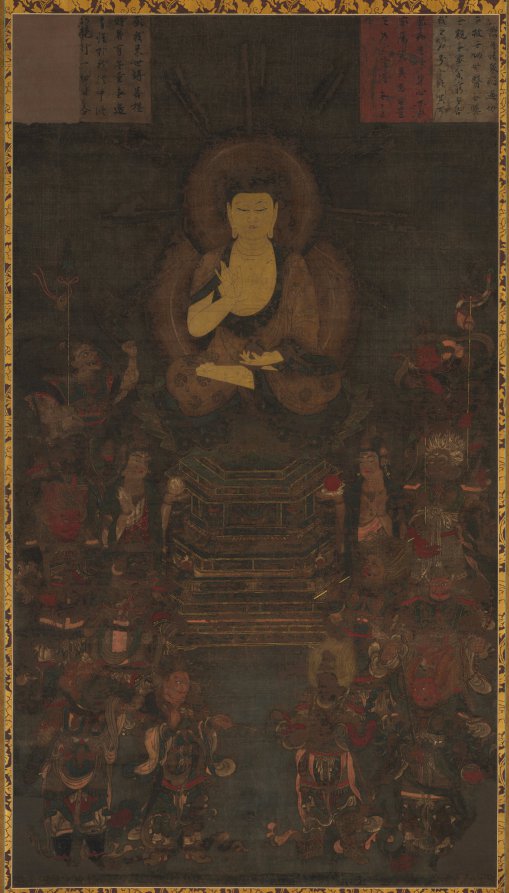| schema:description 13 | "creditline: Edward L. Whittemore Fund" |
| schema:description | "年代・世紀:鎌倉時代・13世紀" |
| schema:description | "id: 117808" |
| schema:description | "digital_description: In the 700s, people in Japan began praying to the Medicine Master Buddha (Yakushi Nyorai) for longevity. Many sculptures of him were made, but there are few painted images like this one. Yakushi is at the center, flanked left and right by the bodhisattvas of the sun and moon, Nikkō and Gakkō, and surrounded by the protective Twelve Divine Generals. Yakushi sits in a meditative pose with his right hand in a gesture bestowing fearlessness, and his left hand holding a medicine jar. Much gold is used in illustrating the patterns of the generals’ clothing, while Yakushi’s robes feature silver in their details. In the upper part of the painting are rectangles painted to simulate colored and patterned paper slips used for inscriptions. They contain excerpts from a sacred text about Yakushi in which he asks that sick people who speak his name should become well, and that all who hear his name might have their purity restored....(more)" |
| schema:description | "員数:1幅" |
| schema:description | "culture: Japan, Kamakura period (1185-1333)" |
| schema:description | "type: Painting" |
| schema:description | "collection: ASIAN - Hanging scroll" |
| schema:description | "measurements: Image: 151.2 x 84.1 cm (59 1/2 x 33 1/8 in.); Overall: 261 x 106.6 cm (102 3/4 x 41 15/16 in.); with knobs: 261 x 113.3 cm (102 3/4 x 44 5/8 in.)...(more)" |
| schema:description | "tombstone: Medicine Master Buddha (Yakushi Nyorai) and the Twelve Divine Generals (Junishinsho), 1200s. Japan, Kamakura period (1185-1333). Hanging scroll; ink, color, and gold on silk; image: 151.2 x 84.1 cm (59 1/2 x 33 1/8 in.); overall: 261 x 106.6 cm (102 3/4 x 41 15/16 in.); with knobs: 261 x 113.3 cm (102 3/4 x 44 5/8 in.). The Cleveland Museum of Art, Edward L. Whittemore Fund 1938.422...(more)" |
| schema:description | "wall_description: Yakushi, the Buddha of Healing, is identified by the medicine jar held in the palm of its left hand. It was among the earliest deities brought to Japan from Korea, probably in the 600s, as a portable gilt bronze image. Here Yakushi is aided and protected by 12 heavenly generals, each representing a month in the year, symbolizing the deity's abundant and timeless powers. Sometime in the 1960s this work underwent conservation that removed the upper and lower roller bar portions of the mounting so that the painting could be placed in a frame. This was done out of concern for the deterioration of the silk ground that was cracking due to the rolling and unrolling of the painting. We have since learned, however, that the continued exposure of silk and mineral pigments to air accelerates structural as well as surface damage. As a result the painting was converted back to the traditional hanging scroll format following an intense conservation treatment that included replacing old silk patches with new ones whose thickness and texture more closely matches the original silk. This reduces the stress that occurs naturally between old and new silk sections during the process of rolling and unrolling the hanging scroll....(more)" |
| schema:description | "作者等:" |
| schema:description | "technique: Hanging scroll; ink, color, and gold on silk" |

